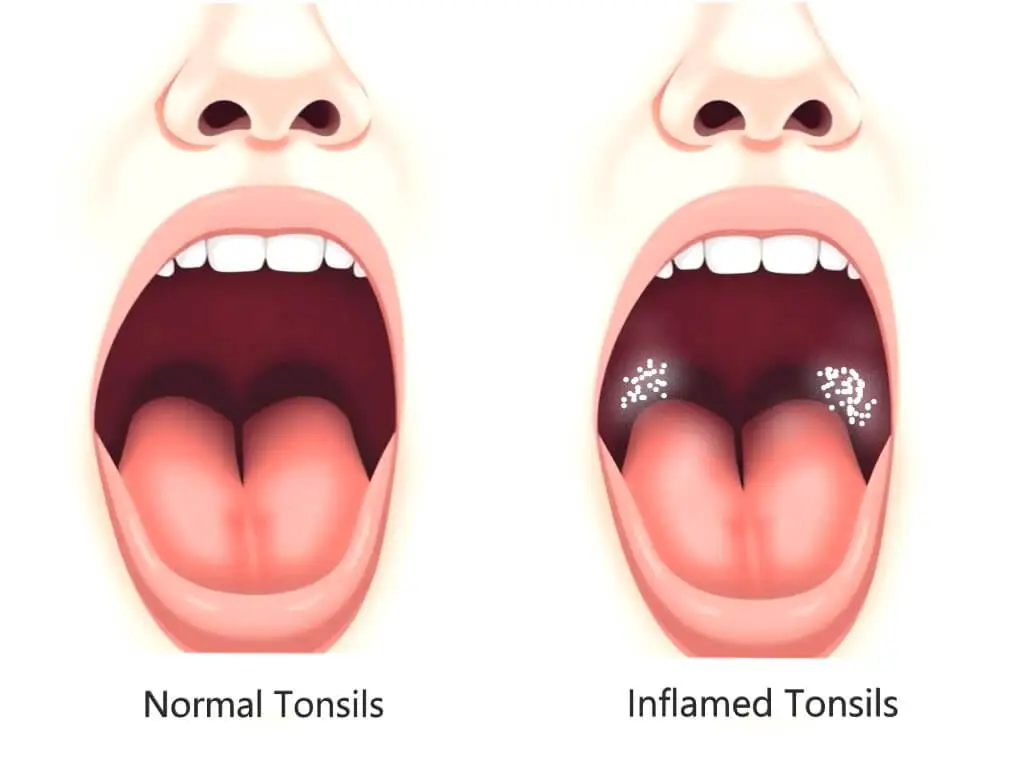A Sneak Peek at What's Inside
What is Tonsillitis
Tonsillitis is the inflammation of the tonsils, which are two lymphoid tissues located at the back of the throat, one tonsil on each side. This condition can be caused by viral or bacterial infections and is characterized by signs and symptoms such as sore throat, difficulty swallowing, and swollen tonsils, tender lymph node on the neck area. The basic function of the tonsils is to trap and filter debris (pathogens) entering the throat and airway to cause infections, also play a vital role in immune response by generating white blood cell (antibodies) to fight infections. When it becomes overwhelmed by bacteria and viruses, it becomes inflamed and swollen. Tonsillitis is particularly common among children (preschoolers) and adolescents, although it can affect individuals of all ages. Tonsillitis is also known as sore throat and medically called tonsillopharyngitis

Inflamed Tonsils
Incidence of Tonsillitis
Tonsillitis is a prevalent condition, particularly in children and teenagers than adult population. Studies indicate that approximately 15% of children experience acute episodes of tonsillitis annually, with the highest rates occurring in those aged 5 to 15 years. Boys are slightly more susceptible than do girls. In the UK, 100 per 1000 population have prevalent recurrent episode of sore throat which indicate that, tonsillitis is a significant health concern
Risk factors of Tonsillitis
Age:Children between the ages of 5 and 15, are at a higher risk of developing tonsillitis due to their developing immune systems. Elderly are also at higher risk of getting sore throat.
Seasonal Variation:Tonsillitis is more prevalent during hot weathers and cold seasons when respiratory infections are common.
Family History:A history of recurrent episodes of tonsillitis in the family may predispose individuals to the condition.
Frequent exposure to germs:Close contact with peers, especially children in daycare or school settings are more likely to contract infections from infectious agent. Adult who spend more time with kids such as teachers and daycare mothers, are also likely of contraction infections.
Individuals living or working in close proximity to airborne pollutants, such as smoke, dust are also at risk.
Causes of Tonsillitis
The primary causes of tonsillitis are generally as a results of infection, most often by viruses and bacteria. Common viruses include the Epstein-Barr virus (EBV), cytomegalovirus (CMV), adenoviruses, and Coxsackievirus. The most common bacterial causing tonsillitis is Group A beta-hemolytic Streptococcus (GABHS, or Group A streptococcus), which is the bacterium responsible for strep throat. Other bacteria, such as Staphylococcus aureus, and strains of strep can also cause tonsillitis.
Types Tonsillitis
Tonsillitis can be categorized into various forms according to their symptoms and recovery period. They include:
Acute tonsillitis:Sudden onset of symptoms and usually last 3 to 4 days or up to 2 weeks depending the cause. It is usually caused by virial or bacterial infection.
Chronic tonsillitis:Characterize by recurrent inflammation of the tonsils. Individuals will have an ongoing symptom that may persist for months and includes sore throat and foul-smelling breath.
Recurrent tonsillitis:This is characterized by multiple episodes of acute tonsillitis in a year. It may lead to surgical intervention, tonsillectomy if frequent episodes persist.
Pathophysiology of Tonsillitis
The tonsils, as part of the lymphatic system has a vital role to play in human immunity, thus help to trap and combat harmful microorganisms from causing infections. When the tonsils become overwhelmed, pathogens invade and infiltrate the tonsils. As a result, they become inflamed which triggers inflammatory response, causing redness, swelling and pain. The inflamed tonsils then release pro-inflammatory cytokines, amplifying immune response. This further leads to systemic symptoms such as fever, headache and malaise
Signs & Symptoms of Tonsillitis
Symptoms of tonsillitis typically develop suddenly and may include:
- Sore throat
- Red, swollen tonsils
- White or yellow patches or pus on the tonsil
- Difficulty swallowing (odynophagia)
- Fever
- Loss of appetite
- Tender swollen lymph nodes in the neck
- Bad breath (halitosis)
- A scratchy or muffled voice
- Headache and general malaise.
- Stiff neck
Diagnostic Investigations & Test
Diagnosis of tonsillitis is primarily clinical, based on the patient's symptoms and physical examination. Treatment of tonsillitis differ significantly from viral to bacterial causative, hence it is important to distinguish between viral and bacterial tonsillitis
- Physical examination
- Throat swap for culture or Rapid antigen detection test to identify the presence of GABHS.
- Blood test – Full blood count (FBC)
You may also like: Everything you need to know about Pharyngitis
Tonsillitis Treatment
Tonsillitis is a self-limiting condition among individuals. Treatment of tonsillitis depends generally on the underlying cause. The mainstay of treating viral tonsillitis is by supportive care, focusing on symptom relief through hydration, rest, and over-the-counter (OTC) pain relievers like ibuprofen or acetaminophen. NSAIDs are also prescribe to provide symptomatic relive.
Bacterial tonsillitis is managed by prescribed antibiotics, particularly for GABHS based on throat culture and antigen testing. Penicillins are generally the choice of antibiotic. If patient is allergic to penicillin, azithromycin, clindamycin or cephalosporins is considered.
In cases of recurrent or chronic tonsillitis, surgical intervention, such as tonsillectomy (surgical removal of the tonsils) or tonsillotomy may be recommended.
Classical differences between Virial and Bacterial Tonsillitis
| Feature | Viral | Bacterial |
|---|---|---|
| Causes | Viruses (e.g., EBV, adenovirus) | Bacteria (primarily GABHS) |
| Symptom Onset | Gradual onset | Sudden onset |
| Fever | Usually mild | Often high |
| Tonsil Appearance | Red and swollen, may have gray/white patches or coating | Red and swollen, often with white patches |
| Pain Level | Moderate to severe | Severe |
| Diagnosis | Clinical evaluation | Throat culture or rapid tests |
| Treatment | Supportive care | Antibiotics plus supportive care |
| Duration | Resolves in a day to about a week | Symptoms improve within 1-2 days of antibiotics |
Complications of Tonsillitis
Tonsillitis is typically self-limiting disease and symptomatically managed with good clinical outcomes, but severe complications do occur if left untreated, complications include:
- Peritonsillar Abscess (Quinsy): Collection of pus that develops between one of the tonsils and the wall of the throat causing severe pain and difficulty swallowing.
- Chronic Tonsillitis
- Rheumatic Fever
- Scarlet Fever
- Acute Glomerulonephritis
Preventive measures
Tonsillitis cannot be totally prevented, however, certain measures can help reduce the risk. Practice and teach your child to:
- Practicing Good Hygiene: Regular handwashing, especially touching the nose or mouth after sneezing.
- Avoiding close contact with infected individuals can help prevent the spread of infections
- To cough or sneeze into a tissue or, when necessary, into his or her elbow
- Staying away from smoke and other irritants can reduce the risk of throat infections.
- Keeping up with vaccinations can help prevent some viral infections that may lead to tonsillitis.
- Keep your child at home when he or she is sick
- Replacing your toothbrush every three months and every time you get sick

